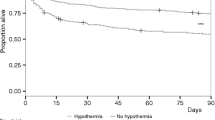Abstract
Background: Hypothermic patients with sepsis have been reported to have a higher mortality than febrile septic patients. The failure to mount a febrile response in sepsis is poorly understood. Since the proinflammatory cytokines play a crucial role in the genesis of fever, we postulated that hypothermic patients with sepsis would have lower circulating levels of these cytokines than febrile patients¶Methods: Patients with septic shock who were enrolled into the placebo limb of the North American study of the safety and efficacy of murine monoclonal antibody to tumor necrosis factor for the treatment of septic shock (NORASEPT II) were analyzed. Body temperature, interleukin-6, tumor necrosis factor α, soluble tumor necrosis factor receptor-55, and soluble tumor necrosis factor receptor-75 concentrations were measured at enrollment. The study population was divided into a hypothermic (temperature ≤ 35.6 °C) and a febrile group (temperature ≥ 38.3 °C) according to the core temperature at enrollment (normothermia was an exclusion criteria). Clinical, demographic, and cytokine data were extracted, allowing for comparisons between these two groups of patients. In addition, the correlation between the core body temperature and cytokine levels at enrollment was determined¶Results: A complete data set was available for 930 patients; 195 patients (21 %) were hypothermic at enrollment. The 28-day survival of these patients was significantly lower than that of the febrile patients (34 % vs. 59 %, p < 0.001). Hypothermia (and enrollment temperature) were independent predictors of mortality. The hypothermic patients had a higher incidence of organ dysfunction at enrollment than the febrile patients. There was no significant difference in the cytokine profile between the two groups of patients. In addition, there was no correlation between the core body temperature at enrollment and the circulating levels of cytokines measured¶Conclusion: Hypothermic patients with septic shock have a significantly higher mortality with a higher incidence of organ dysfunction than febrile septic shock patients. The hypothermia in these patients cannot be explained by lower levels of circulating proinflammatory cytokines.
Similar content being viewed by others
Author information
Authors and Affiliations
Consortia
Additional information
Received: 3 December 1999 Final revision received: 2 February 2000 Accepted 7 March 2000
Rights and permissions
About this article
Cite this article
Marik, P., Zaloga, G. & and the Norasept II Study Investigators. Hypothermia and cytokines in septic shock. Intensive Care Med 26, 716–721 (2000). https://doi.org/10.1007/s001340051237
Issue Date:
DOI: https://doi.org/10.1007/s001340051237




